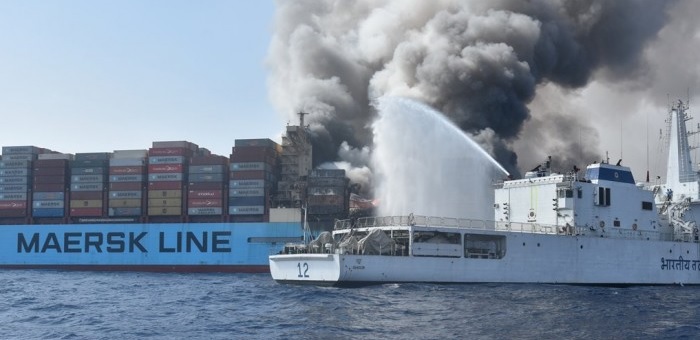On the aftermath of the major fire that killed five crew members onboard the ‘Maersk Honam’ in March, Danish container ship giant Maersk conducted a thorough review of current safety practices and policies in the stowage of dangerous cargo, and has now announced implementation of new guidelines to improve safety across its container vessel fleet.
On 6 March 2018, the container ship ‘Maersk Honam’ suffered a serious fire in its cargo hold where dangerous goods were carried, but up to this time, there is no evidence to suggest that dangerous goods caused the fire, the company noted. In addition, all cargo was accepted as per the requirements of the IMDG Code and stowed onboard the vessel accordingly.
Following the tragic incident, Maersk took measures and implemented additional preliminary guidelines for stowage of dangerous goods. The company evaluated over 3,000 UN numbers of hazardous materials in order to further understand and improve dangerous cargo stowage onboard container vessels and developed a new set of principles called ‘Risk Based Dangerous Goods Stowage’.
Together with ABS, Maersk called for a workshop with other industry stakeholders to conduct a comprehensive Hazard Identification study that validated these new guidelines which have now been implemented across Maersk Line’s fleet of more than 750 vessels. The Risk Based Dangerous Goods Stowage principles have also been presented to the IMO, as well as the Danish Maritime Authorities.
All cargo aboard Maersk Honam was accepted as per the requirements of the International Maritime Dangerous Goods Code and stowed onboard the vessel accordingly. Despite this, as the fire originated in a cargo hold in front of the accommodation which held several containers with dangerous goods, it had an unbearably tragic outcome. This clearly showed us that the international regulations and practices with regards to dangerous goods stowage needs to be reviewed in order to optimally protect crew, cargo, environment and vessels.
…says Ole Graa Jakobsen, Head of Fleet Technology at Maersk.
The Risk Based Dangerous Goods Stowage principles have been developed to minimise risk to crew, cargo, environment and vessel in case a fire develops. The different container vessel designs were reviewed from a risk mitigation perspective and ultimately six different risk zones defined. Namely, the principles include:
- Cargo covered under the IMDG Code will no longer be stowed next to accommodation and main propulsion plant which is defined as the zone with the lowest risk tolerance.
- Similarly, risk tolerance will be low below deck and in the middle of the vessel, whereas the risk tolerance will be higher on deck fore and aft.
- Utilising statistics on container fires in the Cargo Incident Notification System (CINS), Maersk defined which UN numbers can be stored in each risk zone.
Maersk will continue to review its rules and policies for accepting dangerous goods and assess how to further improve them.
Container ship fires are a problem for our entire industry and we intend to share and discuss our learnings from this thorough review within relevant industry forums. We very much believe that discussions, views and insights among container carriers can further improve fire safety in our industry,
…added Ole Graa Jakobsen.
In the coming months, a review aimed at creating best management practices for dangerous goods stowage will be undertaken with participation from ABS, Lloyds Register, the International Group of PandI Clubs, National Cargo Bureau, the TT Club and Exis Technologies. Once the project is completed the best management practices will be published and presented to the IMO.


























































